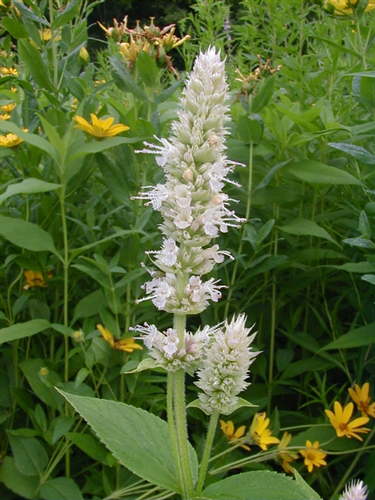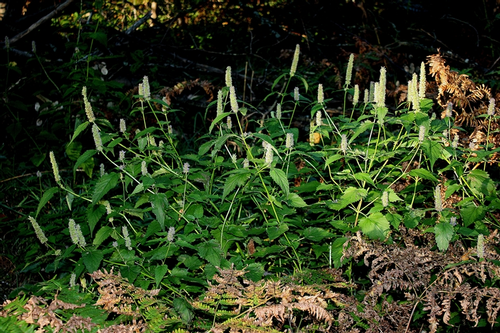Plants and Animals
Agastache scrophulariifolia Purple giant-hyssop
Key Characteristics
Perennial herb of forest edges, in the mint family 0.6–1.2 m tall, with short square stems which may be slightly hairy. Leaves are opposite, have coarse teeth, a rounded base and pointed tip, and are up to 10 cm long and 5 cm wide. The undersides of the leaves are hairless (glabrous) to long, fine haired (villous), mainly on the veins. Lavender to pale pink (occasionally white) tubular flowers grow in spikes ranging from 2–15 cm long and 1.5–2 cm thick. Flowers are 5 mm long with four long stamens.
This species is similar in appearance to yellow giant hyssop (A. nepetoides), which has yellow flowers. The leaves of A. scrophulariifolia are pubescent mainly on the veins beneath, compared with all over pubescence of A. nepetoides leaves.
Status and Rank
US Status: No Status/Not Listed
State Status: SC - Special Concern (rare or uncertain; not legally protected)
Global Rank: G4 - Apparently secure
State Rank: SNR - Not ranked
Occurrences
| County | Number of Occurrences | Year Last Observed |
|---|
Information is summarized from MNFI's database of rare species and community occurrences. Data may not reflect true distribution since much of the state has not been thoroughly surveyed.
Habitat
Known occurrences in Michigan are in the southern Lower Peninsula in the following counties: Cass, Ionia, Kent, Lenawee, Oakland, St. Clair, Washtenaw, and Wayne. Typically found along forest borders, in clearings, both dry and moist forests, and floodplains. The species requires a partial canopy and somewhat moist and sandy soil conditions. This species can also be found along roadsides.
Natural Community Types
For each species, lists of natural communities were derived from review of the nearly 6,500 element occurrences in the MNFI database, in addition to herbarium label data for some taxa. In most cases, at least one specimen record exists for each listed natural community. For certain taxa, especially poorly collected or extirpated species of prairie and savanna habitats, natural community lists were derived from inferences from collection sites and habitat preferences in immediately adjacent states (particularly Indiana and Illinois). Natural communities are not listed for those species documented only from altered or ruderal habitats in Michigan, especially for taxa that occur in a variety of habitats outside of the state.
Natural communities are not listed in order of frequency of occurrence, but are rather derived from the full set of natural communities, organized by Ecological Group. In many cases, the general habitat descriptions should provide greater clarity and direction to the surveyor. In future versions of the Rare Species Explorer, we hope to incorporate natural community fidelity ranks for each taxon.
Associated Plants
Maidenhair fern (Adiantum pedatum), white snakeroot (Ageratina altissima), hog-peanut (Amphicarpa bracteate), spreading dogbane (Apocynum androsaemifolium), Jack-in-the-pulpit (Arisaema triphyllum), wild ginger (Asarum canadense), lady fern (Athyrium filix-femina), satin brome (Bromus nottawayanus), sedges (Carex cephalophora, C. pensylvanica, C. rosea), shagbark hickory (Carya ovata), enchanter’s-nightshade (Circaea canadensis), Canada wild rye (Elymus canadensis), green-stemmed Joe-Pye-weed (Eutrochium purpureum), shining bedstraw (Galium concinnum), white avens (Geum canadense), hairy sunflower (Helianthus hirsutus), pale-leaved sunflower (H. strumosus), Virginia waterleaf (Hydrophyllum virginianum), clustered-leaved tick-trefoil (Hylodesmum glutinosum), false spikenard (Maianthemum racemosum), ostrich fern (Matteuccia struthiopteris), ironwood (Ostrya virginiana), jumpseed (Persicaria virginianum), Solomon-seal (Polygonatum biflorum), white oak (Quercus alba), Hill’s oak (Q. ellipsoidalis), bur oak (Q. macrocarpa), black oak (Q. velutina), cut-leaf coneflower (Rudbeckia laciniata), three-lobed coneflower (Rudbeckia triloba), Canada goldenrod (Solidago canadensis), late goldenrod (S. gigantea), and elm-leaved goldenrod (S. ulmifolia), Drummond’s aster (Symphyotrichum drummondii), calico aster (S. lateriflorum), Short’s aster (S. shortii), arrow-leaved aster (S. urophyllum), slippery elm (Ulmus rubra), and riverbank grape (Vitis riparia) (Wilhelm and Rericha 2017, Consortium of Midwest Herbaria 2023).
Management Recommendations
A status survey for this species is warranted in partially shaded forests edges, clearings, and riparian zones of southern lower Michigan. Maintain healthy intact, mature forests, and minimize fragmentation. When possible, leave large tracts of unharvested forests and allow natural processes to operate unhindered.
Survey Methods
Random meander search covers areas that appear likely to have rare taxa, based on habitat and the judgment of the investigator.
-
Meander Search
-
Survey Period: From fourth week of July to first week of October
-
References
Survey References
- Elzinga, C.L., D.W. Salzer, and J.W. Willoughby. 1998. Measuring and Monitoring Plant Populations. The Nature Conservancy and Bureau of Land Management, Denver. BLM Technical Reference 1730-1. 477pp.
- Goff, G.F., G.A. Dawson, and J.J. Rochow. 1982. Site examination for Threatened and Endangered plant species. Environmental Management 6(4): 307-316
- Nelson, J.R. 1984. Rare Plant Field Survey Guidelines. In: J.P. Smith and R. York. Inventory of rare and endangered vascular plants of California. 3rd Ed. California Native Plant Society, Berkeley. 174pp.
- Nelson, J.R. 1986. Rare Plant Surveys: Techniques For Impact Assessment. Natural Areas Journal 5(3):18-30.
- Nelson, J.R. 1987. Rare Plant Surveys: Techniques for Impact Assessment. In: Conservation and management of rare and endangered plants. Ed. T.S. Elias. California Native Plant Society, Sacramento. 8pp.
Technical References
- Consortium of Midwest Herbaria. 2023. https://midwestherbaria.org/portal/index.php. Accessed 20 December 2023.
- GBIF.org. 2023. GBIF Occurrence Download <https://doi.org/10.15468/dl.8khsg2>. Accessed 20 December 2023.
- Gleason, H. A., and A. Cronquist. 1991. Manual of vascular plants of Northeastern United States and adjacent Canada. The New York Botanical Garden.
- iNaturalist. 2023. https://www.inaturalist.org/taxa/158084-Agastache-scrophulariifolia. Accessed 20 December 2023.
- Minnesota Wildflowers. N.D. Web. Available at: https://www.minnesotawildflowers.info/flower/purple-giant-hyssop. Accessed 20 December 2023.
- Reznicek, A. A., E. G. Voss, and B. S. Walters. 2011. Agastache scrophulariifolia (Willd.) Kuntze. Michigan Flora Online. University of Michigan. Web. Available at: https://www.michiganflora.net/record/1534. Accessed 20 December 2023.
- Voss, E. G., and A. A. Reznicek. 2012. Field Manual of Michigan Flora. University of Michigan Press, Ann Arbor, Michigan, USA. 990 pp.
- Wilhelm, G., and L. Rericha. 2017. Flora of the Chicago Region. Indiana Academy of Science, Indianapolis.




